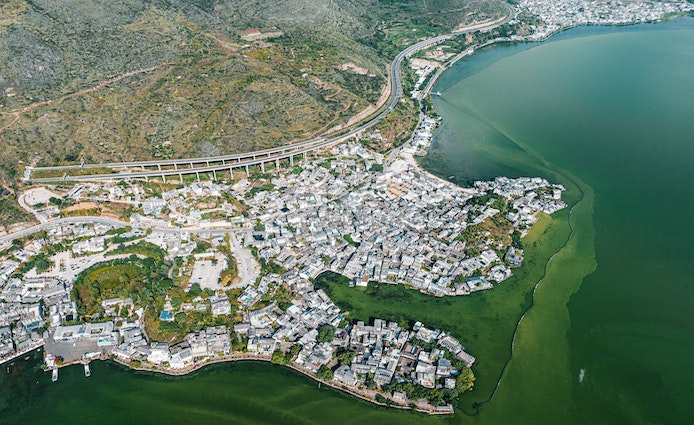
Dainchi Lake

Dianchi Lake also known as Lake Dian and Kunming Lake, is a large lake located on the Yunnan-Guizhou Plateau close to Kunming, Yunnan, China. Its nickname is the "Sparkling Pearl Embedded in a Highland" and it was the model for the Kunming Lake in the Summer Palace in Beijing. Its name is the source of Yunnan's Chinese abbreviation Dian.
The character Dian was first found in the Records of the Grand Historian as the name of the Dian Kingdom. Modern studies suggest that the element "Dian" is derived from the language of the ancient extinct Bo people and means basin. The character Dian was used as the name of the lake since the Han dynasty set "Dianchi County" in 109 BC. Dianchi Lake was the site of the capital of the independent kingdom of the Cuan during the first millennium AD. At that time, it was known as Kunchuan.
It is a freshwater fault lake at 1,886.5 m above sea level. The lake covers 298 km2. It is 39 km long from north to south, and the average depth is 4.4 m. It is the eighth-largest lake in China and the largest in Yunnan Province.
Together with other Yunnan lakes (Fuxian, Qilu, Yangzong, Xingyun, and Yilong), Dian Lake is recognized as an ecoregion. Among three major Yunnan lakes with a high number of endemics, the other two being Fuxian and Erhai, the most drastic loss of biodiversity has been seen in the Dian. Of the 25 native fish species and subspecies in Dian Lake, 10 are endemic to the basin. Today the only endemic fish known to survive in the lake itself is Anabarilius alburnops, but it is endangered. The remaining have not been recorded there since the 1990s or earlier, and most of these are likely extinct. Two other species, Schizothorax grahami and Yunnanilus nigromaculatus, are endemic to the general region but have also disappeared from Dian Lake itself.
Among the non-endemic natives, only goldfish and Asian swamp eel still live in Dian Lake. In contrast to the status of the natives, the lake is now home to more than 25 introduced fish species. The Yunnan lake newt (Cynops wolterstorffi) was endemic to the lake, but it has not been seen since 1979 and is considered extinct.
Photo Credit: Unsplash
Reference: Wikipedia
If there's any copyright issue involved, please contact us to delete.



